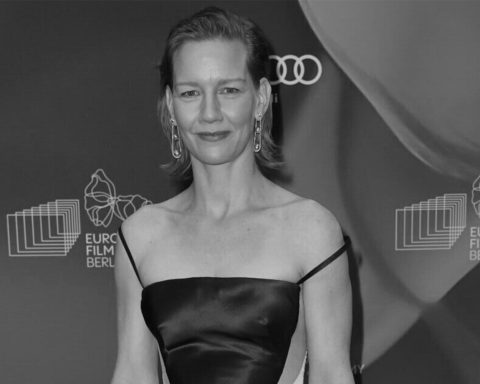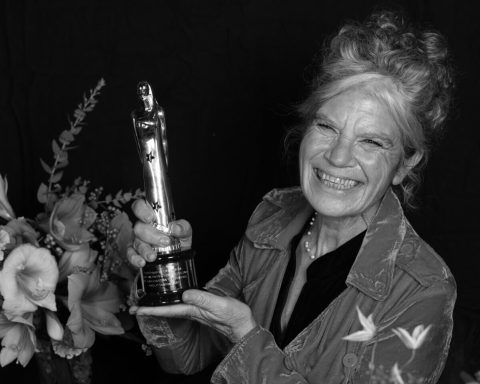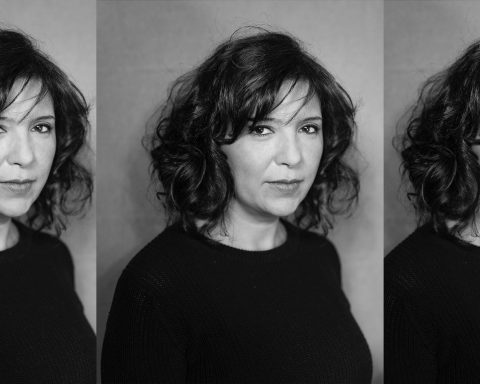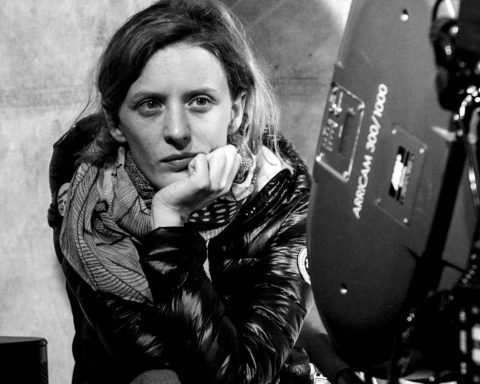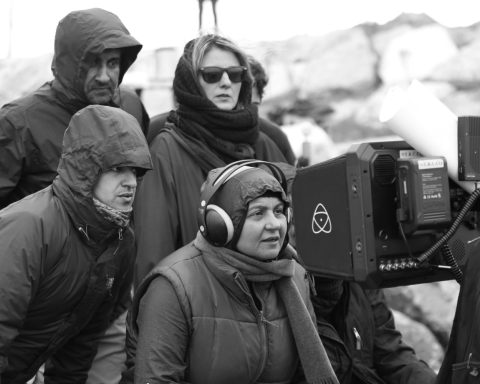Aga Woszczyńska is a director, scriptwriter, and anthropologist from Poland. In 2008, she graduated in Applied Social Sciences from the University of Warsaw and in 2014 in Directing from The Polish National Film School in Lodz with the short film “Fragments.” She worked as a production manager and assistant director in Poland and abroad on numerous film and commercial projects. She wrote and directed ten short films that traveled the festival circuit and were sold to broadcasters internationally. “Fragments” premiered in the Directors’ Fortnight sidebar of the Cannes Film Festival in 2014. Since then, the film has screened at more than sixty film festivals around the globe, winning many awards. She is a Ministry of Culture scholar and has received the Discovering Eye Award for Most Interesting Emerging Artist in the U.S.
Tara Karajica talks to Aga Woszczyńska about “Silent Land,” her debut feature that premiered in the Platform Competition program of this year’s Toronto International Film Festival, women in film today, and what she is working on next.
How did you get into filmmaking?
Aga Woszczyńska: I have been directing since I was a kid! Let’s just say that there was a family theater where my parents and grandparents were recruited by me as the main actors. In my later years, I embarked on a journey in Visual Anthropology and attended film and photography classes before officially enrolling into Film School in Lodz, Poland.
How did Silent Land come about?
A.W.: It took me about five years to make this film. My graduation film, Fragments, which premiered in the Directors’ Fortnight section at the Cannes Film Festival in 2014, is actually a short film about the same couple, Anna and Adam, played by the same the same actors as in Silent Land, Agnieszka Zulewska and Dobromir Dimecki, and shot by the same brilliant cinematographer, Bartosz Swiniarski. While Fragments was more about Anna, Silent Land is more about Adam, but I thought that these twenty-five minutes of my short film were not enough to tell the full story of my characters, to get to know them better, understand them and perhaps even forgive them. So, this was the first point. The second point is that I started writing the script when the immigrants’ tragedy happened on the island of Lampedusa, and it became clear that I had to make a commentary about a situation I found absolutely devastating and appalling. It was very important to me that Silent Land be regarded as more than just a story about a couple. I wouldn’t want to invest five years of my life just to tell a story about a couple’s relationship demise. I always need something more, on a meta-level, that is also about something more important. And that’s why I made this film.
Can you talk about the title?
A.W.: “Silent Land…” Well, the literal sense of the word “land” refers to that of Italy, where the film itself is set. Metaphorically, “land” reflects on the whole of Europe and, I dare even say, on the rest of the world; the word “silent” refers to our general reaction on the tragedy of immigrants. Furthermore, I would argue that my film is silent in terms of form and style: the photography can be considered “silent” because it is not overwhelming visually speaking, and there is a lot of silence between my characters who cannot communicate with each other simply because they cannot feel and express their emotions.
Indeed, the film is very quiet, very observant, very still with a static camera and reminiscent of Antonioni in its mood. Can you talk about these choices?
A.W.: While in film school, you discover what you really want to do. For me, it was the kind of slow cinema where you have time to be with your characters and to ponder on what you see on screen. I’m all about long takes and static shots. There is no music in Silent Land, because to me, music emphasizes emotions, almost dictating to the viewer: “Now, you have to cry! Now, you have to be scared! Now, you have to laugh!” I wanted no part in that. I didn’t want to (mis)lead my audience; I just want them and the screen in communion, nothing more. I would argue that the meticulous sound design in my film, created by the talented Marek Poledna, is in fact a kind of soundtrack. Also, I tend to use as little dialogue as possible in my films. In my mind, cinema starts where the words end… and where the image carries meanings and emotions. This film was made because of my love for classic European directors, like Antonioni, so we also added some grain in post-production, to make it more like stock image. Most scenes were shot in one take, and I’m really happy I managed to do this. Sometimes, more important things happen beyond the frame than within the frame itself.
Even on holiday, Anna and Adam have a meticulously planned daily routine with a lot of emphasis on their eating and their fitness regime. They are also very distant, their interactions are cold, very tense without any complicity. Can you talk about them?
A.W.: This daily routine makes them feel safe, which explains why, at the end, Anna insists on going back to these previously established patterns of behavior that make her feel safe and comfortable. This couple identifies comfort and convenience with happiness: when you know what you are supposed to do everyday, you have everything under control and you are not afraid of anything. I also wanted to display the meta-level of this sense of safety. They purposefully chose a house with CCTV cameras and an alarm system, simply for the sake of building their cocoon of safety. This, to me, is a perfect metaphor for Europe: we want to feel safe because of this supposed threat of immigrants that is actually deeply irrational.
With their appearance – so white and so blonde with blue eyes – you show a very stark contrast with the pool repairman and in doing so, you show the blatant racism and the difference between the East and the West. You also show the racism from the perspective of the Italians. And, finally, you show the difference between them as people and the Italians and the way they think, behave and handle the case. Can you expand on that?
A.W.: First of all, I want to underline that nobody in this film is either just good or just bad; there are a lot of nuances within the personality of each character. I wanted to show Adam’s change in personality, to be on his side, to defend and forgive him when he finally comes to the full realization of what he did – or rather what he didn’t do – when the Arab pool repairman needed his help. Adam took his guilt upon himself. In another scene, the worker Rahim struggles to communicate in English with Anna, but it’s not his fault; that’s just the reality of this character’s life. But Anna is not even making a single effort to try and understand him. I find this kind of dismissive behavior very cruel.
About the Italians: well, to be perfectly honest, I need to profess my love for Italy! I spent a lot of time in Calabria, in the south of Italy, where I wanted to shoot this film at the beginning, but we ended up on the beautiful island of Sardinia. I like the Italian characters in my film. They are not perfect, but who is? Eventually, I don’t consider them as bad people.
Everything is cold, restrained and tense from the beginning to end on more than one level – in the mise-en-scène, the cinematography, how they behave, how they interact with each other and with other people… Can you delve into these choices?
A.W.: Actually, for me, form is content, so I cannot distinguish between the mise-en-scène, the camera and the story because I consider everything to be on the same level of importance. I wanted to make a film about people who are unable to feel, plain and simple. They don’t really want to deal with bad emotions, so it’s far better for them not to feel at all. In this sense, Adam is going through a change throughout the film. I don’t know what will happen to him when he goes back to Warsaw, but I suspect he won’t be the same person. I didn’t want to illustrate my film with dialogues, but rather illustrate my characters’ emotions, their states and their restraint via images; to me, powerful pictures say much more than thousands of lines of dialogue.
Can you talk about working with Agnieszka Zulewska and Dobromir Dimecki on Silent Land? How did you prepare them for these roles in comparison with Fragments?
A.W.: Aga and Drobomir know each other so well. They are not just my actors, but also my friends. I adore working with them; they are very intelligent and sensitive. And I trust them completely.
The preparation process on Silent Land was more or less the same as it was on Fragments. 90 % of our work was done before the shoot, even before rehearsals. It was a long period of conversations, with us analyzing the script and characters together.
I wanted them to get to know exactly who they were and what they wanted as characters before we even started shooting. On set, my only advice was to make them play their character either harder or weaker. We were actually very prepared. I think Agnieszka and Dobromir liked this way of working with me; I feel like it gave them a sense of security.
Are you a feminist? If so, how does it inform your filmmaking?
A.W.: Of course, I’m a feminist, but honestly, I don’t think I’m in a worse position as a filmmaker based on my gender.
What is your take on the situation of women in film today? How is it in Poland? Do you see any changes? Do you see more opportunities for women?
A.W.: Let me put it this way: On September 7, my beloved friend, Ola Jankowska, had the world premiere of her film, Anatomia, in the Giornate degli Autori section of the Venice Film Festival. A month later, my other brilliant friend, Aleksandra Terpinska, will premiere the most anticipated Polish film, Other People, distributed by Warner in Poland. Meanwhile, none of my fellow male students from my former school year have made a film. Not to forget that my wonderful producer, Aga Wasiak, who actually made Silent Land happen is also female. So, I can’t really say it’s getting worse because I think it’s getting much, much better; many more women are making very interesting films in Poland. I can only speak for myself, but I don’t feel bad at all about being a woman in the film industry, to be perfectly honest.
Do you have a favorite female filmmaker and a favorite film by a female filmmaker?
A.W.: That’s a very difficult question because it makes me realize that all of my favorite directors are male! But I have a great admiration for Lynne Ramsay; she treats form as content, which is really important to me. In her brilliant We Need to Talk About Kevin, she concocts a family story into something that is so much more, taking her story to a meta-level concerning the condition of our contemporary, wealthy society in which there is no place for failure. She speaks about the world where the need of convenience is the most important and is identified with happiness. I find this kind of strong commentary shocking and wonderful at the same time.
What are your next projects?
A.W.: I have already received development funds from the Polish Film Institute for my second feature, Black Water. It’s a story that came to me during the COVID lockdown. This tale is about two female strangers trapped on a Scandinavian island due to an ecological catastrophe. This bizarre time of captivity helps them discover themselves and each other, and also understand what real freedom is. It will be a neo noir thriller where arthouse meets genre cinema. I am also slowly starting to think about my third feature, White Fire, which will be about men this time. In this film, I plan to take them to a Pacific island to make them confront the spirits of their ancestors.
This interview was conducted virtually at the 2021 Toronto International Film Festival.






